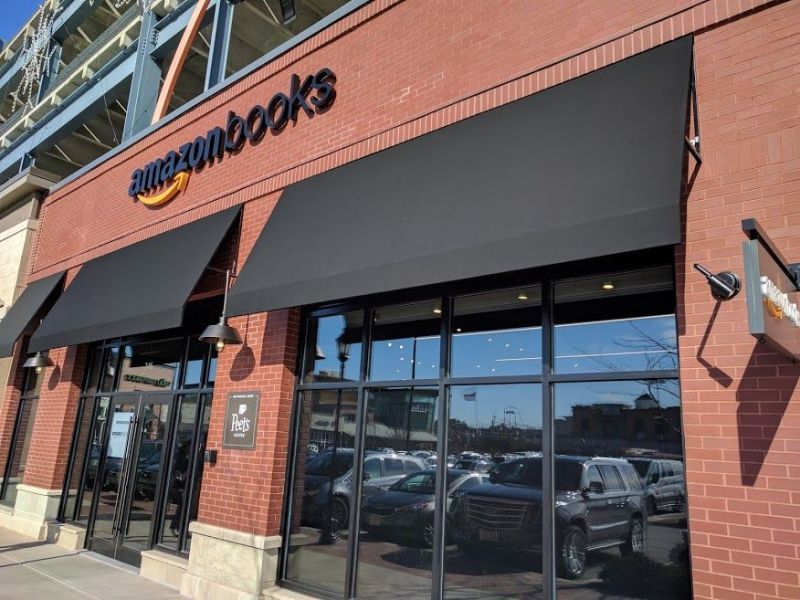A Summer at Amazon Books
by
Rachael Allen
You walk into a bookstore. Something is different, you think. You pay for a cold brew from Peet’s Coffee & Tea, located in the rear of the store, then walk around, assessing.
Perhaps it’s the orientation of the books: they all face out, squared shoulders, as if presenting their best selves to a potential new owner. Perhaps it’s the black review cards tacked below each book, giving you booklover22’s opinion on why All the Light We Cannot See was so moving. Perhaps it’s the devices zone in the middle of the store. A couple pokes at a tablet, while a little boy dances to Ed Sheeran, whose music is now spouting from the voice-activated speaker, per his request.
Perhaps, too, it’s your awareness of the store name you walked into—Amazon Books. Choose your own adventure: are you
- excited you have access to your mom’s Prime and thereby will get store discount, or
- frustrated that the online giant has ventured even further into independent bookstore territory by setting up a brick-and-mortar, or
- simply pleased that a bookstore has popped up in your area?
Welcome to Amazon Books, where I worked this summer. Let me know if I can help you find—Oh. You already know the title? Okay, let me look it up for you. I’m sorry, we only have it online. Yes, we have that one in stock! I’ll walk you over to it.

With eight stores across the country and five more coming soon, Amazon Books has given people a new point of access to the world’s most popular online shopping site since the first store opened in Seattle in 2015. Though a section of the store displays Amazon’s Kindles, tablets, and Alexa devices, the store is definitively—thankfully—a bookstore. Main caveat: customer ratings primarily determine which books are in store. While the store’s “New Hardcover Fiction” and “Top Nonfiction Sellers” displays parallel those of most other bookstores, inside the stacks of each genre the selection appears more limited.
Rachael’s name badge hanging beside an Amazon bookshelf.
Surprisingly, perhaps, the book selection does not feel stiff or expected. As much as the books depend on popularity, too many good books have been written for this reviewer to feel that she already knows them. (And, that’s not to say these are all “good” books—even though Amazon has “curated” these books thoroughly, you’re still picking which ones actually win for you.)
This is exactly the point of the store. One can buy whatever book they want or need online. Amazon Books intends to help people browse. While wandering the stacks of fiction, you find that classic you read in middle school and felt went over your head. Or, in biography, you see that memoir that your co-worker was talking about—perhaps it’ll be the next Wild? You may not usually read science books, but they’re on the way to the graphic novels, and the cover of Neil DeGrasse Tyson’s lowdown on astrophysics is looking directly at you.
It’s an added perk that one saves typically 30 to 50 percent with a Prime membership.
Each week new books come into the store, leaving employees like me who think they’ve seen every cover in the store perpetually browsing as we work. I read Shel Silverstein’s The Giving Tree for the first time, noticing it on a display of Highly Rated Children’s Books. I came home with the first book of poetry I’ve bought for myself, Mary Oliver’s Dog Songs. I had my mom buy the book club hit of a few summer’s back—Maria Semple’s Where’d You Go, Bernadette?—so we could each read it. I fell in love with Jhumpa Lahiri’s The Namesake over a family vacation and returned to work only to find it only a shelf below one of my long-time favorite books. I just hadn’t noticed it before.
I have a photo album of book covers from the store on my phone—reminders of what to read next, reminders of how many stories can co-exist.
In short, this summer, I became more well-versed in books, branching out from my usual fiction and nonfiction. I learned how to recommend a book for a ten-year old who claims to hate reading and for a social worker who wants something light and heartwarming for her vacation. I still bought the majority of my books at independent bookstores this summer. Those stores remain cozier than Amazon. And yet, at least in my area, I find that they have become much more out of the way—no longer a trip to the local bookseller.
To the customers who enter and make a comment, straightforward or sarcastic, about how Amazon is taking over the world: yes, it probably is. Did Amazon put bookstores out of business? What about chains like Barnes & Noble or, most directly, all the people who choose to order online? Like any company, Amazon is working to meet people’s reflected needs: fast delivery, access to obscure and used books, discounted prices, etc. I too am mourning the decline of the independent bookstore, but I believe it’s possible for me to support Amazon’s newest venture to promote reading too. I’m glad we still want bookstores, in all their varying forms.
***

Rachael Allen is a senior at Bowdoin College studying English and Italian. She works as a managing editor for Bowdoin’s newspaper, The Bowdoin Orient, and is a frequent contributor to Fictional Café. She loves to write (and read) both fiction and nonfiction, including monthly columns for her local newspaper. You can read these columns as well as her other work on her blog: https://rachaelallenblog.wordpress.com.


